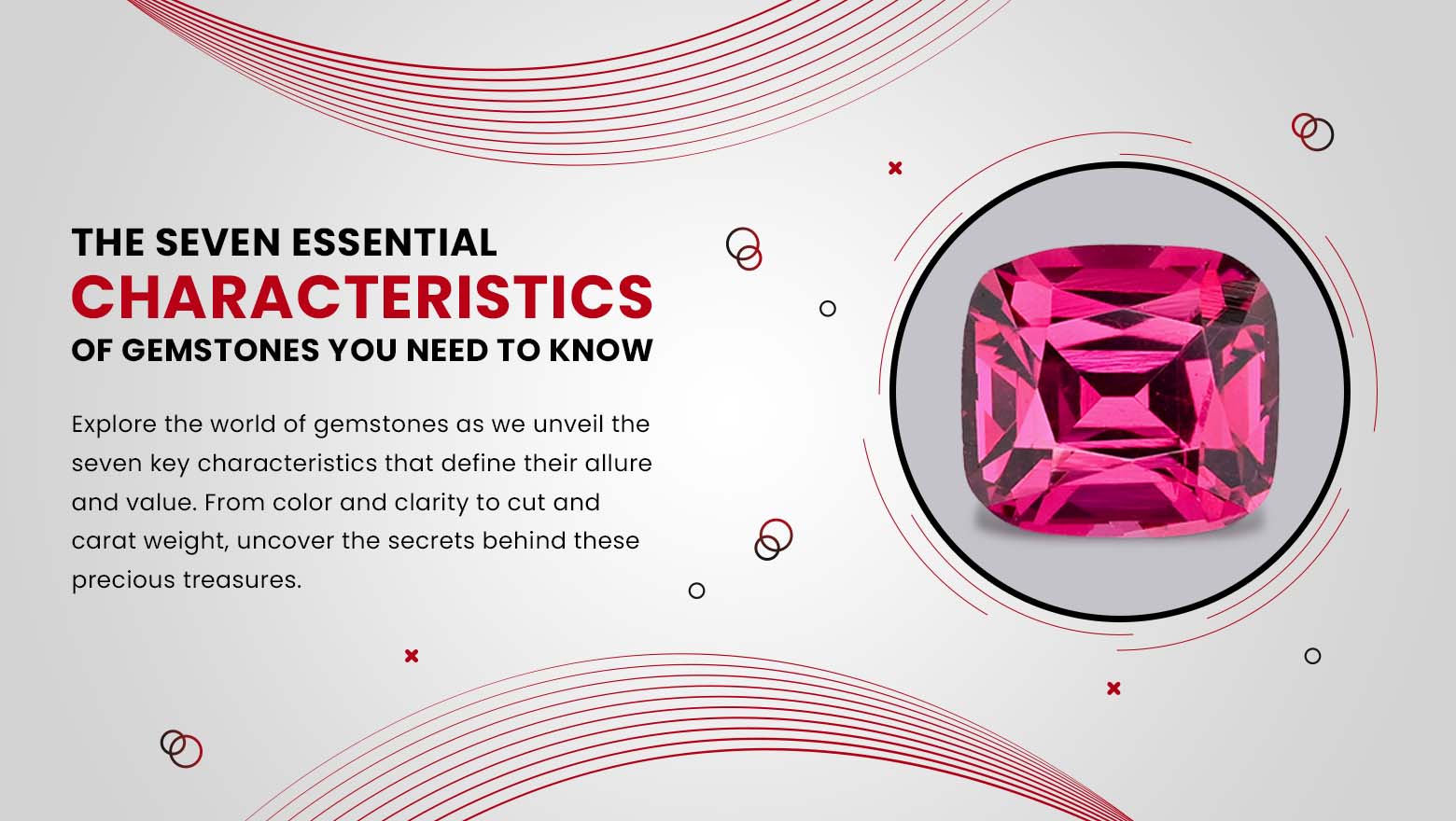The Seven Essential Characteristics of Gemstones You Need to Know

Gemstones have captivated humanity for centuries with their exquisite beauty and captivating allure. From the dazzling sparkle of diamonds to the rich hues of emeralds and sapphires.
These natural treasures have adorned the crowns of kings and queens, symbolized love and commitment in engagement rings, and served as timeless heirlooms passed down through generations.
In today’s world, gemstones continue to hold a special place in our hearts and adorn our lives in various forms of jewelry, from elegant necklaces to sparkling earrings.
Whether it’s the shimmering brilliance of a ruby, the serene blue of a topaz, or the deep green of an emerald, each gemstone possesses its unique characteristics that make it a cherished and sought-after treasure.
But beyond their beauty, gemstones hold a world of fascinating attributes waiting to be explored. Understanding these characteristics is not only essential for appreciating their value but also for making informed decisions when purchasing or admiring these precious gems.
In this article, we will delve into the seven key characteristics of gemstones that every enthusiast should know. From hardness to color, clarity to cut, we’ll uncover the secrets behind what makes each gemstone truly extraordinary.
Seven Essential Characteristics of Gemstones
The seven characteristics of gemstones are given below one by one:
1. Color
Color is perhaps the most captivating aspect of gemstones, captivating our senses with its vibrant spectrum. Beyond mere aesthetics, color is pivotal in determining a gemstone’s value and rarity, making it a crucial characteristic for enthusiasts to understand.
The mesmerizing hues of gemstones are often a result of various factors, each contributing to its unique charm.
Trace elements, such as chromium in emeralds or iron in sapphires, infuse gemstones with their distinct colors during their formation process.
Structural defects within the crystal lattice can also influence color, altering how light interacts with the gemstone and giving rise to a kaleidoscope of shades.
But color goes beyond mere pigmentation; it holds symbolic and cultural significance across different societies.
From the regal allure of a deep blue sapphire to the fiery passion of a ruby’s red, each hue carries its own meaning and evokes emotions that transcend borders and cultures.
Understanding the significance of color in gemstones not only enhances our appreciation for their beauty but also empowers us to make informed decisions when selecting or admiring these precious treasures.
2. Clarity
In the world of gemstones, clarity is like peering into a crystal ball—it reveals the inner world of these precious gems. Simply put, clarity refers to how clear or transparent a gemstone appears to the naked eye, and it’s a key factor in assessing its quality and value.
When examining a gemstone’s clarity, gemologists look for any internal features called inclusions and external marks known as blemishes.
Inclusions are tiny imperfections that form within the gemstone as it crystallizes, while blemishes are surface irregularities caused by natural processes or human intervention.
These characteristics can range from minuscule specks to more noticeable flaws, each affecting the gemstone’s appearance and value in unique ways.
While flawless gemstones are incredibly rare and highly prized, the presence of inclusions and blemishes isn’t necessarily a negative trait.
They can serve as identifying markers, helping gemologists authenticate and distinguish one gemstone from another.
Moreover, some inclusions, like the mesmerizing “star” in a star sapphire or the ethereal “cat’s eye” effect in a chrysoberyl, add to the gemstone’s allure and value.
Understanding clarity allows us to appreciate the beauty of gemstones in a new light, recognizing the intricate world within each precious stone.
3. Cut
In the world of gemstones, the cut is the artisan’s brushstroke, transforming rough stones into dazzling jewels that capture the light and hearts alike.
More than just shaping, the cut is a masterful art form that enhances a gemstone’s beauty and brilliance.
Imagine a rough diamond, unassuming and dull. It’s the cut that unlocks its potential, allowing light to dance within and reflect in a mesmerizing display of sparkle.
Different types of cuts—each with its own technique and style—play a vital role in shaping a gemstone’s appearance and value.
Faceted cuts, with their precisely angled surfaces, maximize a gemstone’s brilliance by refracting light into a spectrum of colors.
Cabochon cuts, on the other hand, feature smooth, rounded surfaces that showcase a gemstone’s natural colors and textures.
And then there are mixed cuts, combining elements of both to create a unique blend of sparkle and depth.
But the cut isn’t just about aesthetics; it’s also about precision and craftsmanship.
A well-cut gemstone will exhibit symmetry, proportions, and polish, enhancing its overall beauty and value.
Conversely, a poorly cut gemstone may appear lifeless and lackluster, diminishing its allure and desirability.
Understanding the importance of cut allows us to appreciate the artistry behind every gemstone and how it transforms raw materials into exquisite works of art.
4. Carat Weight
In the realm of gemstones, carat weight is the universal language of size and stature, speaking volumes about a gemstone’s presence and value.
But what exactly does carat weight entail, and why is it so significant?
Carat weight measures a gemstone’s mass, with one-carat equivalent to 200 milligrams. It’s a straightforward concept—more carats mean a larger gemstone—but its implications go far beyond mere size.
Carat weight plays a crucial role in determining a gemstone’s rarity, with larger stones often commanding higher prices due to their scarcity.
However, carat weight isn’t the sole determinant of a gemstone’s value. Factors such as color, clarity, and cut also influence its overall worth.
A smaller gemstone with exceptional color and clarity may be more valuable than a larger one with inferior characteristics.
Moreover, carat weight can vary across different gemstone types.
For instance, diamonds are commonly measured in carats, while colored gemstones like rubies and sapphires may be measured in carats or carats’ total weight (CTW) for multiple stones.
Understanding carat weight allows us to appreciate the significance of size in the world of gemstones and how it factors into their overall value.
5. Hardness
In the dazzling world of gemstones, hardness is the unsung hero, quietly ensuring the longevity and resilience of these precious treasures.
But what exactly is hardness, and why is it so crucial for gemstones?
Enter the Mohs scale of mineral hardness, a simple yet profound tool that ranks minerals based on their scratch resistance.
Ranging from 1 (softest) to 10 (hardest), this scale provides a clear measure of a gemstone’s durability and suitability for use in jewelry.
At the softer end of the scale, we find delicate gems like talc and gypsum, prone to scratches and abrasions.
Moving up the scale, we encounter gems like quartz (7) and topaz (8), offering moderate durability suitable for everyday wear.
Finally, at the pinnacle, we have the illustrious diamond (10), renowned for its unparalleled hardness and resilience against wear and tear.
But why does hardness matter? Imagine a beloved engagement ring, cherished for a lifetime.
Its gemstone, subjected to daily wear, must withstand the rigors of everyday life without losing its luster or brilliance.
Here, hardness becomes paramount, ensuring that the gemstone retains its beauty and elegance for generations to come.
Understanding the significance of hardness allows us to appreciate the durability and resilience of gemstones, ensuring that they remain timeless symbols of love and beauty.
6. Luster
In the radiant world of gemstones, luster is the heartbeat that infuses them with brilliance and allure, captivating our gaze and igniting our imagination. But what exactly is luster, and how does it define a gemstone’s character?
Luster refers to the way light interacts with the surface of a gemstone, giving rise to its shine and glow. It’s a captivating quality that adds depth and dimension to these precious treasures, transforming them into mesmerizing works of art.
There are several types of luster, each with its distinctive charm and personality. Adamantine luster, characterized by a brilliant, diamond-like sparkle, adorns gems like diamonds and zircon with an ethereal glow that mesmerizes the beholder.
Vitreous luster, reminiscent of glass, lends gems like quartz and tourmaline a captivating sheen that dances in the light.
And then there’s metallic luster, imbuing gems like pyrite and hematite with a captivating gleam that echoes the richness of precious metals.
But luster isn’t just about surface appearance—it’s a reflection of a gemstone’s inner beauty and character.
From the fiery brilliance of a ruby to the serene glow of a moonstone, each gemstone’s luster tells a story of its unique journey through time and nature.
Understanding the concept of luster allows us to appreciate the radiant beauty of gemstones and how they illuminate our world with their timeless elegance.
7. Rarity and Origin
In the enchanting world of gemstones, rarity, and origin are the hidden gems that add mystique and allure to these natural treasures.
But what makes a gemstone rare, and why does its origin matter?
Rarity is like a whisper of magic, infusing gemstones with an air of exclusivity and desirability. Factors such as scarcity of the material, unique geological conditions, and even historical significance contribute to a gemstone’s rarity.
For example, the deep blue hues of Kashmir sapphires are renowned for their rarity, stemming from the region’s specific geological conditions that produce these mesmerizing gems.
Origin, on the other hand, is the storyteller that weaves a narrative of a gemstone’s journey through time and space.
A gemstone’s origin not only affects its value but also adds to its allure and desirability.
For instance, Colombian emeralds are celebrated for their lush green color and exceptional clarity, owing to the unique geological formations of the region.
Understanding the importance of rarity and origin allows us to appreciate the true value of gemstones beyond their outward beauty.
It’s a glimpse into the Earth’s hidden treasures and a testament to the wonders of nature’s craftsmanship.
Conclusion
Throughout this exploration of gemstone characteristics, we’ve delved deep into the heart of these natural treasures, uncovering their mesmerizing beauty and timeless allure.
Each characteristic reveals a unique facet of gemstones ‘ captivating charm, from the radiant spectrum of color to the enduring strength of hardness.
We’ve learned how the significance of color goes beyond aesthetics, reflecting cultural symbolism and emotional resonance.
Clarity has shown us the intricate world within gemstones, where imperfections tell stories of nature’s craftsmanship.
The cut has emerged as a masterful art form, shaping gemstones into dazzling jewels that capture the light and hearts alike.
Carat weight has unveiled the measure of magnificence, while hardness stands as the pillar of durability, ensuring the resilience of these precious treasures.
Luster has illuminated the inner glow of gemstones, captivating our gaze and igniting our imagination.
Lastly, rarity and origin have whispered tales of the Earth’s hidden treasures, adding mystique and allure to every gemstone’s journey.
Together, these characteristics form the essence of gemstones, unlocking the secrets of their timeless elegance and enduring beauty. They are more than mere adornments; they are storytellers, reflecting the wonders of nature’s craftsmanship and the rich tapestry of human culture and history.
As we conclude our journey through the world of gemstones, let us carry with us a newfound appreciation for these natural wonders and the stories they hold within.
May they continue to enchant and inspire us for generations to come, as we marvel at the enduring magic of gemstones.
So, This is the complete information about the Seven Essential Characteristics of Gemstones, I hope you have gone through it.
If you have any kind of question or suggestion you can ask in the comments section below.
Or
If you want any kind of consultation, feel free to contact us.
Thank you for reading.

